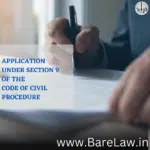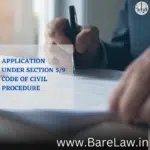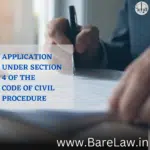
Table of Contents
ANOTHER FORM OF CAVEAT
Draft
ANOTHER FORM OF CAVEAT
IN THE COURT OF THE………………..
Civil Original/appellate/revisional Jurisdiction.
Suit/Appeal/Revision/Misc. Application/Petition/Execution
………………. No………………… of 19………………..
Plaintiff(s)
Appellant(s)
Applicant(s)
Petitioner(s)
versus
Defendant(s)
Respondent(s)
CAVEAT
Sir,
May your Honour please, let nothing be done in the suit/appeal/Revision/ Execution/Petition aforesaid, without notice to me/us.
Dated this the……………….. day of……………….. 19………………..
(Advocate(s)
For Defendant(s)
Respondent(s)
Third Party
Intervenor(s)
Any information regarding the matter may be sent to me/us at the following address
Advocate(s)
CASE LAW
Section 148A
LIMITATION FOR FILING CAVEAT
The maximum limit of 90 days is prescribed by sub-cl. (5) of Section 148A, C. P. C. and if it is filed earlier, it must be renewed1.
CONDITIONS FOR MAKING THE CAVEAT EFFECTIVE
In order to make the caveat effective the analogy of this section can be applied. A caveat may be filed even before the date of pronouncement of judgment in an extreme case where no dates for orders or judgments are fixed and the order is of administrative nature. In other cases as far as possible, caveats should be entertained after judgments are pronounced. The name of the Court or Authority should also be mentioned2.
NECESSITY TO INFORM THE PERSON LIKELY TO FILE THE CASE.
It is also necessary that the caveator should inform the person who is likely to file application or writ and such notice should be sent by registered post according to R. 159(3) of the High Court Rules read with S. 148A C. P. C.3
NECESSITY OF SERVICE OF APPLICATION ON CAVEATOR
Where once a caveat is filed, it is a condition precedent for passing an interim order to serve a notice of the application on the caveator who is going to be affected by the interim order4.
LIMITATION FOR FILING CAVEAT
The maximum limit of 90 days is prescribed by sub-cl. (5) of Section 148A, C. P. C. and if it is filed earlier, it must be renewed5.
CONDITIONS FOR MAKING THE CAVEAT EFFECTIVE.
In order to make the caveat effective the analogy of this section can be applied. A caveat may be filed even before the date of pronouncement of judgment in an extreme case where no dates for orders or judgments are fixed and the order is of administrative nature. In other cases as far as possible, caveats should be entertained after judgments are pronounced. The name of the Court or Authority should also be mentioned6.
NECESSARY TO INFORM THE PERSON LIKELY TO FILE THE CASE.
It is also necessary that the caveator should inform the person who is likely to file application or writ and such notice should be sent by registered post according to R. 159(3) of the High Court Rules read with S. 148A C. P. C. 7.
NECESSITY OF SERVICE OF APPLICATION ON CAVEATOR
Where once a caveat is filed, it is a condition precedent for passing an interim order to serve a notice of the application on the caveator who is going to be affected by the interim order8.
CAVEATOR — RIGHT OF
Section 148A
Under Section 148A of Civil PC, the Caveator has a right to be heard if any application is filed and since appeal under section 100 CPC is not an application its notice need not be issued to caveator at the stage of admission. 9
1. Pashupatinath v. Registrar Co-operative Societies, A. I. R. 1983 Raj. 191: 1982 Raj. L. R. 694.
2. Pashupatinath v. Registrar Co-operative Societies, A. I. R. 1983 Raj. 191: 1982 Raj. L. R. 694.
3. Pashupatinath v. Registrar Co-operative Societies, A. I. R. 1983 Raj. 191: 1982 Raj. L. R. 694.
4. G. C. Siddalingappa v. G. C. Veeranna, A. I. R. 1981 Kant. 242: (1981) 2 Kant. L. J. 325.
5. Pashupatinath v. Registrar Co-operative Societies, A. I. R. 1983 Raj. 19!: 1982 Raj. L. R. 694.
6. Pashupatinath v. Registrar Co-operative Societies, A. I. R. 1983 Raj. 191: !982 Raj. L. R. 694.
7. Pashupatinath v. Registrar Co-operative Societies, A. I. R. 1983 Raj. 191: 1982 Raj. L. R. 694.
8. G. C. Siddalingappa v. G. C. Veeranna, A. I. R. 1981 Kant. 242: (1981) 2 Kant. L. J. 325.
9. Badami Kumari Patna v. Purna Chandra Jena, 2000 (4) CCC 21 (Orissa).



